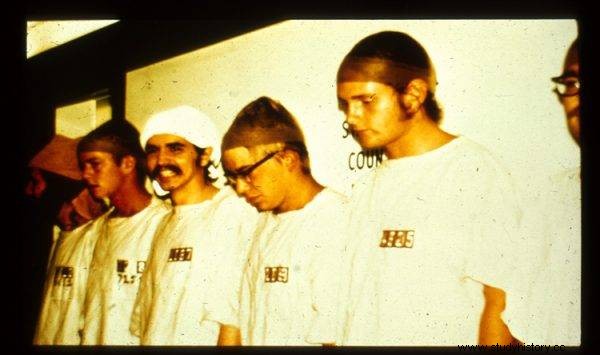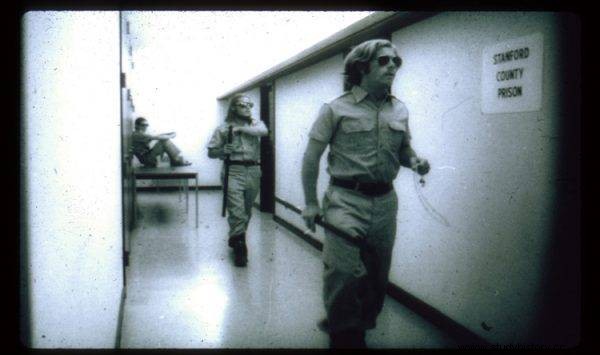In 1971, a prison was established at Stanford University. It was founded by a scientist, Philip Zimbardo. His experiment almost ended tragically.
This is one of the most famous - and controversial - experiments in the history of psychology, although it lasted only six days. In 1971, 24 volunteers were randomly divided into two groups:"guards" and "prisoners". They were all mentally and physically healthy, unpunished and intelligent. What happened next can be terrifying. And it raises the question of the validity of similar research.
Recruiting prisoners and guards
In the summer of 1971, an announcement to recruit participants appeared in the local Stanford newspaper for psychological examination. It was supposed to be about prison life . The offer was tempting. Volunteers selected will receive $ 15 for each day of the two-week experiment. Conditions:male gender, student status, good psychophysical condition and no disputes with the law in the past.

Based on a select group of normal, healthy, intelligent men - middle class men - our study of prison life began.
The interest was considerable. Over 70 people responded to the advertisement. Ultimately, Philip Zimbardo, the psychologist who led the entire research project, selected 24 young men . Eighteen of them (half as prisoners, half as guards) was soon to be sent to a "maximum security prison", that is, rooms specially adapted for this purpose in the basement of the psychology department at Stanford University. Six were a reserve. As Zimbardo recalled:
To eliminate candidates with a criminal history, drug, psychological or physical problems, they underwent diagnostic interviews and personality tests. (...) Our chosen ones passed all the tests we carried out and reacted normally in all the situations we observed.
Based on a select group of normal, healthy, intelligent men - middle class men - our study of prison life began. As a result of the coin toss, the boys were divided into two groups (...). It should be remembered that at the beginning of our experiment there were no differences between the playing guards and the prisoners.
Standford County Jail
To make the experiment realistic, "imprisonment" was preceded by an arrest. Zimbardo managed to get the police to cooperate with Palo Alto. On the first day of the study, on Sunday August 15, students were detained by police officers on suspicion of armed robbery . Their rights were read, handcuffed, and then - at the police station - fingerprints were taken and photos were taken for the file. The participants were shocked. Of course, they realized that they were to be imprisoned, but no one informed them about the planned arrests. Zimbardo wanted this to be a surprise for them.
The day before the police action, on August 14, the "guards" were shown around the penitentiary facility that had been organized by psychologists in the university cellars. In doing so, Zimbardo relied on the descriptions of former convicts and prison staff.

To make the experiment realistic, "imprisonment" was preceded by an arrest.
Three halls turned into cells replacing the door with bars. The nearly 10-meter long corridor was turned into a "main courtyard" with boarded up ends. With the exception of the toilet (where prisoners were led blindfolded so that they would not know the way out), this corridor was the only place where prisoners were allowed to walk, eat or exercise - described the author of the experiment. There was also an isolation room. As Zimbardo recalled:
On the side of the corridor, opposite the cells, there was a small wardrobe that served as our isolation room, the so-called The "hole". It was dark and very cramped - about 60 cm high and just as deep - yet high enough for the "evil prisoner" to stand in it.
In addition, a changing room for guards, a guard room and the director's office were organized in three more rooms Stanford County Jail - as the fictional facility was called. The role of the latter was played by Zimbardo himself. He later admitted that it was a mistake because he got too emotionally involved in the experiment. Anyway, as he was repeatedly pointed out to him, this was not the only wrong assumption.
The course of the experiment
There were no windows or clocks in the prison. Instead, there was an intercom, through which prisoners were eavesdropped and communicated to them by the director, and a camera recording the image in the "courtyard". In order to better reflect the prison atmosphere, the guards were allowed to choose their uniforms and equipment. The next day, they showed up for "work" in khaki-colored shirts and sunglasses (!), With truncheons at the waist . The task was simple :to deprive the inmates of their privacy and prevent them from escaping (then the experiment would be stopped). Physical violence was forbidden. The batons were to remain only symbols of power. The rest was entirely up to them.
The guards were supposed to work in threes (if necessary, they could call for backup). One "shift" lasted eight hours. The prisoners were to be held in their cells of three for 24 hours a day. They were told that they would receive minimal food rations. They could also expect violations of privacy and civil rights.

Stanford County Jail - this was the name of the fictional facility
After escorting from the police station to Stanford County Jail, they were stripped naked, searched and deloused. Instead of their clothes, they received long white shirts with identification numbers on the front and on the back, and rubber sandals (no underwear). They each had a chain padlocked to their right leg. They were to wear "caps" made of stockings on their heads. They were forbidden to use their first names. From then on, they were to address each other by identification numbers. If they wanted to say something to the guard, they had to use the phrase "sir penitentiary officers". All this was intended to strip them of their dignity and create an impression of anonymity. Zimbardo translated:
It should be clear that we have tried to create a functional simulation of a prison, not a literal prison. Real prisoners don't wear dresses, but feel humiliated and unmanly . Our goal was to quickly achieve this effect by wearing naked dresses for men . After donning their uniforms, some prisoners actually started walking and sitting differently - more like women.
Sadists and victims
After the first day of "work", the guards were confused. Prisoners mocked the methods of discipline involving the compulsory counting of identification numbers (they were wrenched from sleep with the help of whistles) or punitive push-ups. Despite these resistance to the first demonstrations of power, the experiment promised to be peaceful. As Zimbardo recalled:
(...) we were completely surprised and unprepared for the revolt that broke out the next morning . The prisoners took their stocking caps off their heads, ripped off the identification numbers and barricaded themselves in cells blocking the entrances with bunks. (…) The guards were also angry and frustrated because the prisoners started calling them names and mocking them.
Ultimately, they managed to deal with the prisoners' revolt. For this purpose, used a carbon dioxide fire extinguisher that chilled the skin . Then they stormed the cells, forced the inmates to undress and took their beds . The initiators of the action were locked up in solitary confinement. The persecution and intimidation of the prisoners began. Since corporal punishment was forbidden, the guards resorted to psychological violence. For the "good prisoners" they organized a "privileged cell" and then began to swap "good" and "bad" places causing complete confusion among them. Our consultant (a former inmate) revealed to us that similar tactics are used in real prisons to break the alliance among prisoners - commented Zimbardo.
It became a privilege to eat (the "bad prisoners" had their food rations taken) and even to use the toilet. After turning off the lights at 22 inmates had to empty themselves into buckets left in their cells. Soon the prison began to reek of feces. The violence escalated. At one point, the guards forced their "charges" to simulate homosexual acts!
A real prison
The first participant - prisoner number 8612 - began to "break" after less than 36 hours. He was even offered a deal:to be an informant in exchange for indulgent treatment, but he was in such a bad mental state that eventually the researchers decided to release him. The next day, to ease the mood, the inmates were given an hour of visits for their families and friends. Zimbardo described:
The entire visit took place in the presence of a guard. However, before one could meet the prisoner, it was necessary to consult the warden. Of course my parents complained about all these rules, but oddly enough they were adapting . In this way, the most ordinary, good parents also became, in a sense, actors in our prison performance.

The violence escalated. At one point, the guards forced their "charges" to simulate homosexual acts!
An attempt to improve the atmosphere in the prison has failed. One of the guards overheard the prisoners talking about the great escape. To prevent it, the researchers even asked the local police for help. This is best evidence of how the line between experiment and real life has blurred. Although rumors of the escape turned out to be rumors, the guards increased the intensity of the persecution. (…) they made prisoners do push-ups, jumpers, whatever they thought, increasing the countdowns to a few hours each - recalled the author of the study.
The excessive realism of the experimental situation was also evidenced by the visit of a Catholic priest, a former prison chaplain, whom Zimbardo invited to his "institution":, not the name (...). The priest's visit blurred the boundaries between role playing and reality even more.
A groundbreaking study, or maybe ... a bad theater?
After six days, the experiment had to be stopped. Meanwhile, another prisoner - number 819 - had a nervous breakdown. The rest were organized a dismissal commission. One of the "new" inmates (from the reserve group) decided to go on a hunger strike. We have created an extremely powerful situation - a situation in which the prisoners withdrew and behaved pathologically, and in which some of the guards behaved sadistically Wrote Zimbardo. However, it was not the prisoners' welfare that led him to decide to end the study, but ... the intervention of his girlfriend, Christina Maslach.

The participants knew they were being watched, so they did not act naturally but played the roles assigned to them
The basic conclusion of the Stanford experiment was :under certain circumstances "good people do evil" - in the words of Zimbardo. The procedure itself, however, was later met with harsh criticism. The organizers were accused of breaking ethical standards and numerous methodological errors. It was argued that the participants knew they were being watched, so they did not act naturally but played their assigned roles . One of the guards, Dave Eshelman, said afterwards: In a way, I was conducting my own experiment there, which was to find out how far I could go before these people told me to stop .
Also controversial is the fact that the study could not be repeated In December 2001, psychologists Stephen Reicher and Alexander Haslam, in collaboration with the BBC, tried to recreate the prison experiment (with some modifications). Their eight-day procedure eliminated expectations unknowingly communicated to participants by scientists. The only instruction the guards were given was to keep the facility running smoothly . The result turned out to be completely contrary to the results of Zimbardo's work. The prisoners quickly formed a common front and after a few days… took over the guards' quarters. So the question about the nature of evil still remains valid.
